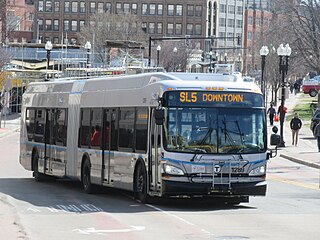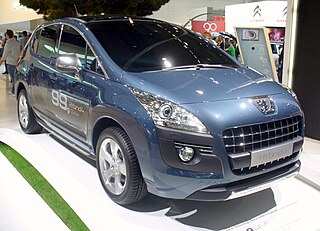Types by design
Parallel hybrid

Parallel hybrid systems have both an internal combustion engine and an electric motor that can both individually drive the car or both coupled up jointly giving drive. This is the most common hybrid system as of 2016.
If they are joined at an axis (in parallel), the speeds at this axis must be identical and the supplied torques will add together (most electric bicycles are of this type). When only one of the two sources is in use, the other must be connected via a one-way clutch or freewheel so it can rotate freely.
With cars the two sources may be applied to the same shaft (for example with the electric motor connected between the engine and transmission), turning at equal speeds and the torques adding up with the electric motor adding or subtracting torque to the system as necessary. (The first two generations of Honda Insight use this system.)
Parallel hybrids can be further categorized by the balance between the different motors are at providing motive power: the ICE may be dominant (engaging the electric motor only in specific circumstances) or vice versa; while in others can run on the electric system alone but because current parallel hybrids are unable to provide electric-only or internal combustion-only modes they are often categorized as mild hybrids (see below).
Parallel hybrids rely more on regenerative braking and the ICE can also act as a generator for supplemental recharging. This makes them more efficient in urban 'stop-and-go' conditions. They use a smaller battery pack than other hybrids. Honda's early Insight, Civic, and Accord hybrids using IMA are examples of production parallel hybrids. [2] General Motors Parallel Hybrid Truck (PHT) and BAS Hybrids such as the Saturn Vue and Aura Greenline and Chevrolet Malibu hybrids also employ a parallel hybrid architecture.
Through the Road (TTR) hybrid
An alternative parallel hybrid is the "through the road" type. [3] [4] In this system a conventional drivetrain powers one axle, with an electric motor or motors driving another. This arrangement was used by the earliest 'off track' trolleybuses. It in effect provides a complete backup power train. In modern motors batteries can be recharged through regenerative braking or by loading the electrically driven wheels during cruise. This allows a simpler approach to power-management. This layout also has the advantage of providing four-wheel-drive in some conditions. (An example of this principle is a bicycle fitted with a front hub motor, which assists the cyclist's pedal power at the rear wheel.) Vehicles of this type include the Audi 100 Duo II and Subaru VIZIV concept cars, Peugeot 3008, Peugeot 508, 508 RXH, Citroën DS5 (all using PSA's HYbrid4 system), the Volvo V60 plug-in hybrid, the BMW 2 Series Active Tourer, BMW i8 and the second generation Honda NSX.
Series hybrid

Series hybrids are also referred to as extended-range electric vehicles (EREV) [5] or range-extended electric vehicles (REEV), or electric vehicle with extended range (EVER). All series hybrids are EREV, REEV or EVER, but not all EREV, REEV or EVER are series hybrids. Series hybrids with particular characteristics are classified as range-extended battery-electric vehicle (BEVx) by the California Air Resources Board. [6]
Electric transmission has been available as an alternative to conventional mechanical transmissions since 1903. Typically mechanical transmissions impose many penalties, including weight, bulk, noise, cost, complexity and a drain on engine power with every gear-change, whether accomplished manually or automatically. Unlike ICEs, electric motors do not require a transmission.
In effect the entire mechanical transmission between the ICE and the wheels is removed and replaced by an electric generator, some cable and controls, and electric traction motors, with the benefit that the ICE is no longer directly connected to the demand.
This is a series-hybrid arrangement and is common in diesel–electric locomotives and ships (the Russian river ship Vandal, launched in 1903, was the world's first diesel-powered and diesel–electric powered vessel) and Ferdinand Porsche successfully used this arrangement in the early 20th century in racing cars, including the Lohner–Porsche Mixte Hybrid. Porsche named the system System Mixte, which had a wheel hub motor arrangement, with a motor in each of the two front wheels, setting speed records.
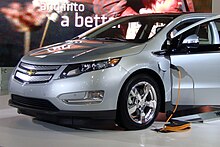
The arguments of greater flexibility, higher efficiency and less emissions at the point of use are achieved in a series-hybrid system for road vehicles when an intermediate electric battery, acting as an energy buffer, sits between the electric generator and the electric traction motors.
The ICE turns a generator and is not mechanically connected to the driving wheels. This isolates the engine from demand, allowing it to consistently operate at its most efficient speed. Since the primary motive power is generated by the battery, a smaller generator/engine can be fitted as compared to a conventional direct drive engine. Electric traction motors can receive electricity from the battery, or directly from the engine/generator or both. Traction motors frequently are powered only by the electric battery, which can be charged from external sources such as the electricity grid.
This allows a vehicle with an engine/generator that only operates when needed, such as when the battery is depleted, or to charge the batteries. Vehicles of this type include Nissan's e-Power line (Note, [7] Serena, [8] Kicks, [9] X-Trail, [10] and Qashqai) [11] using a petrol engine to drive a generator and the EM57 traction motor; [12] Mazda's MX-30, when equipped with a rotary engine/generator range extender; [13] ThunderVolt hybrid transit buses integrated by ISE Corporation; [14] and transit buses fitted with BAE Systems (formerly Lockheed Martin) HybriDrive powertrains. [15] [16]
Electric traction motors
Electric motors are more efficient than ICEs, with high power-to-weight ratios providing torque over a wide speed range. ICEs are most efficient when turning at a constant speed.
ICEs can run optimally when turning a generator. Series-hybrid systems offer smoother acceleration by avoiding gear changes. Series-hybrids incorporate:
- Electric traction only – using only electric motors to turn the wheels.
- ICE – turns only a generator.
- Generator – turned by the ICE to generate electricity and start the engine.
- Battery – energy buffer.
- Regenerative braking – The drive motor becomes a generator and recovers energy by converting kinetic to electrical energy, also slowing the vehicle and preventing thermal losses.
In addition:
- May be plugged into the grid to recharge the battery.
- Supercapacitors assist the battery and recover most energy from braking.
In detail
The electric motor may be entirely fed by electricity from the battery or via the generator turned by the ICE, or both. Such a vehicle conceptually resembles a diesel–electric locomotive with the addition of a battery that may power the vehicle without running the ICE and acting as an energy buffer that is used to accelerate and achieve greater speed; the generator may simultaneously charge the battery and power the electric motor that moves the vehicle.
When the vehicle is stopped the ICE is switched off without idling, while the battery provides whatever power is needed at rest. Vehicles at traffic lights, or in slow moving stop-start traffic need not burn fuel when stationary or moving slowly, reducing emissions.
Series-hybrids can be fitted with a supercapacitor or a flywheel to store regenerative braking energy, which can improve efficiency by recovering energy otherwise lost as heat through the braking system. Because a series-hybrid has no mechanical link between the ICE and the wheels, the engine can run at a constant and efficient rate regardless of vehicle speed, achieving higher efficiency (37%, rather than the ICE average of 20% [17] ) and at low or mixed speeds this could result in ~50% increase in overall efficiency (19% vs 29%).
Lotus offered an engine/generator set design that runs at two speeds, giving 15 kW of electrical power at 1,500 rpm and 35 kW at 3,500 rpm via the integrated electrical generator, [18] used in the Nissan concept Infiniti Emerg-e.
This operating profile allows greater scope for alternative engine designs, such as a microturbine, [19] rotary Atkinson cycle engine or linear combustion engine. [20]
The ICE is matched to the electric engine by comparing the output rates at cruising speed. Generally, output rates for combustion engines are provided for instantaneous (peak) output rates, [21] but in practice these can't be used.
The use of an electric motor driving a wheel directly eliminates the conventional mechanical transmission elements: gearbox, transmission shafts and differential, and can sometimes eliminate flexible couplings.
In 1997, Toyota released the first series-hybrid bus sold in Japan. [22] Designline International of Ashburton, New Zealand produces city buses with a microturbine powered series-hybrid system. Wrightbus produces series hybrid buses including the Gemini 2 and New Routemaster. Supercapacitors combined with a lithium ion battery bank have been used by AFS Trinity in a converted Saturn Vue SUV vehicle. Using supercapacitors they claim up to 150 mpg in a series-hybrid arrangement. [23]
Well known automotive series hybrid models include the variant of the BMW i3 that is equipped with a range extender. Another example of a series hybrid automobile is the Fisker Karma. The Chevrolet Volt is almost a series hybrid, but also includes a mechanical link from the engine to the wheels above 70 mph. [24] [25]
Series-hybrids have been taken up by the aircraft industry. The DA36 E-Star, an aircraft designed by Siemens, Diamond Aircraft and EADS, employs a series hybrid powertrain with the propeller turned by a Siemens 70 kW (94 hp) electric motor. A power sapping propeller speed reduction unit is eliminated. The aim is to reduce fuel consumption and emissions by up to 25 percent. An onboard 40 hp (30 kW) Austro Engine Wankel rotary engine and generator provides the electricity.
The Wankel was chosen because of its small size, low weight and great power to weight ratio. (Wankel engines also run efficiently at a constant speed of approximately 2,000 RPM which is suited to generator operation. Keeping to a constant/narrow band offsets many of the perceived disadvantages of the Wankel engine in automotive applications. [26] )
The electric propeller motor uses electricity stored in batteries, with the engines not operating, to take off and climb reducing sound emissions. The powertrain reduces the weight of the plane by 100 kilos relative to its predecessor. The DA36 E-Star first flew in June 2013, making this the first ever flight of a series hybrid powertrain. Diamond Aircraft state that the technology is scalable to a 100-seat aircraft. [27] [28]
In-wheel motors
If the motors are attached to the vehicle body, flexible couplings are required but not if the traction motors are integrated into the wheels. One disadvantage is that the unsprung mass increases and suspension responsiveness decreases, which impacts ride and potentially safety. However the impact should be minimal as electric motors in wheel hubs such as Hi-Pa Drive, may be very small and light having exceptionally high power-to-weight ratios and braking mechanisms can be lighter as the wheel motors brake the vehicle.
Advantages of individual wheel motors include simplified traction control, all wheel drive if required and a lower floor (useful for buses and other specialised vehicles (some 8x8 all-wheel drive military vehicles use individual wheel motors). Diesel–electric locomotives have used this concept (individual motors driving axles of each pair of wheels) for 70 years. [29] [ full citation needed ]
Other measures include lightweight aluminium wheels to reduce the unsprung mass of the wheel assembly; vehicle designs may be optimized to lower the centre of gravity by locating heavier elements (including battery) at floor level; In a typical road vehicle the power-transmission setup may be smaller and lighter than the equivalent conventional mechanical power-transmission setup, liberating space; the combustion generator set only requires cables to the driving electric motors, increasing flexibility in major component layout spread across a vehicle giving superior weight distribution and maximizing vehicle cabin space and opening up the possibility of superior vehicle designs exploiting this flexibility.
Power-split or series-parallel hybrid
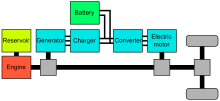
Power-split hybrid or series-parallel hybrid are parallel hybrids that incorporate power-split devices, allowing for power paths from the ICE to the wheels that can be either mechanical or electrical. The main principle is to decouple the power supplied by the primary source from the power demanded by the driver.
ICE torque output is minimal at lower RPMs and conventional vehicles increase engine size to meet market requirements for acceptable initial acceleration. The larger engine has more power than needed for cruising. Electric motors produce full torque at standstill and are well-suited to complement ICE torque deficiency at low RPMs. In a power-split hybrid, a smaller, less flexible, and more efficient engine can be used. The conventional Otto cycle (higher power density, more low-RPM torque, lower fuel efficiency) is often modified to an Atkinson cycle or Miller cycle (lower power density, less low-rpm torque, higher fuel efficiency; sometimes called an Atkinson-Miller cycle). The smaller engine, using a more efficient cycle and often operating in the favorable region of the brake specific fuel consumption map, significantly contributes to the higher overall efficiency of the vehicle.
Interesting variations of the simple design (pictured at right) found, for example, in the well-known Toyota Prius are the:
- fixed-ratio second planetary gearset as used in the Lexus RX400h and Toyota Highlander Hybrid. This allows for a motor with less torque but higher power (and higher maximum rotary speed), i.e. higher power density
- Ravigneaux [30] -type planetary gear (planetary gear with 4 shafts instead of 3) and two clutches as used in the Lexus GS450h. By switching the clutches, the gear ratio from MG2 (the traction motor) to the wheel shaft is switched, either for higher torque or higher speed (up to 250 km/h / 155 mph) while sustaining better transmission efficiency. This is effectively accomplished in the Generation 3 Prius HSDs (Prius v, Prius Plug-in and Prius c), although the Generation 3 HSD has this second planetary gear set fixed at 2.5:1, rather than switching between 1:1 and 2.5:1 as the "carrier" is held fixed.

- Two additional planetary gear sets in combination with four clutches to create a Two-Mode Hybrid configuration able to operate in all-electric, blended electric and ICE, or ICE alone with four fixed gears. Examples of Two-Mode Hybrids include the General Motors Two-Mode Hybrid full-size trucks and SUVs, the BMW X6 ActiveHybrid [31] and the Mercedes ML 450 hybrid. [31]
The Toyota Hybrid System THS / Hybrid Synergy Drive has a single power-split device (incorporated as a single three-shaft planetary gearset) and can be classified as an Input-Split, since the power of the engine is split at the input to the transmission. This in turn makes this setup very simple in mechanical terms, but has drawbacks of its own. For example, in Generation 1 and Generation 2 HSDs maximum speed is mainly limited by the speed of the smaller electric motor (often functioning as a generator). The Generation 3 HSD separates the ICE-MG1 path from the MG2 path, each with its own, tailored gear ratio (1.1:1 and 2.5:1, respectively, for late Priuses, including the Prius c). The Generation 4 HSD eliminates the second planetary gear set, and places the electric motors on parallel axes, with a combining gear in between these axes, and transfers the combined result to the final drive differential. This is quite similar to Toyota-affiliated Aisin Seiki's hybrid system, and saves significant space.
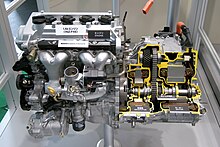

General Motors, BMW, and DaimlerChrysler collaborated on a system named "Two-Mode Hybrid" as part of the Global Hybrid Cooperation. The technology was released in the fall of 2007 on the Chevrolet Tahoe Hybrid. The system was also featured on the GMC Graphite SUV concept vehicle at the 2005 North American International Auto Show in Detroit. [32] BYD Auto's F3DM sedan is a series-parallel plug-in hybrid automobile, which went on sale in China in 2008. [33] [34] [35]
The Two-Mode Hybrid name highlights the drive-train's ability to operate in all-electric (Mode 1, or Input-Split) as well as hybrid (Mode 2, or Compound-Split) modes. The design allows for operation in more than two modes. Two power-split modes are available, along with several fixed-gear (essentially parallel hybrid) regimes. Such a design can be referred to as a multi-regime design. [36] The Two-Mode Hybrid powertrain design can be classified as a compound-split design, since the addition of four clutches within the transmission allows for multiple configurations of engine power-splitting. In addition to the clutches, this transmission has a second planetary gearset. The objective of the design is to vary the percentage of mechanically vs. electrically transmitted power to cope both with low-speed and high-speed operating conditions. This enables smaller motors to do the job of larger motors when compared to single-mode systems, because the derived electrical peak power is proportional to the width of the continuous variation range. The four fixed gears enable the Two-Mode Hybrid to function like a conventional parallel hybrid under high continuous power regions such as sustained high speed cruising or trailer towing. Full electric boost is available in fixed-gear modes. [37]












